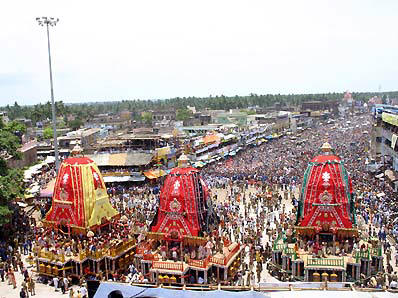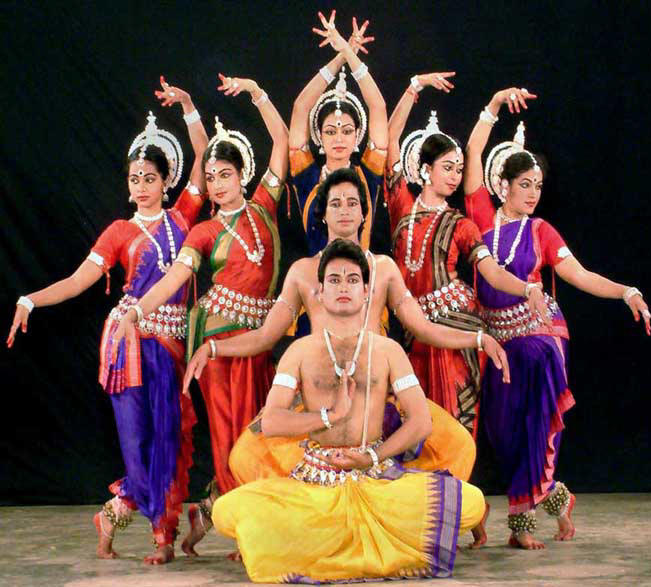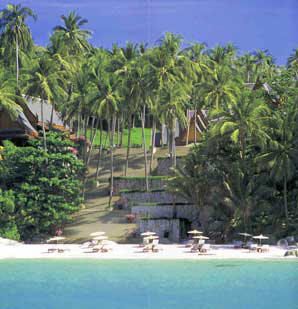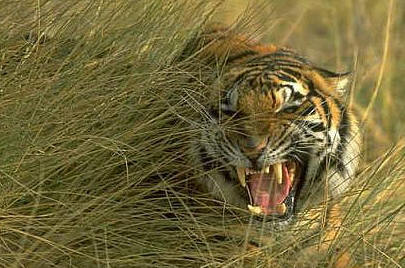Orissa Situated on the coast along the Bay of Bengal, Orissa stands for its ancient glory and modern endeavour. Endowed with nature's bounty, a 482 km stretch of coastline with virgin beaches, serpentine rivers, mighty waterfalls, forest-clad blue hills of Eastern Ghats with rich wild life, Orissa is dotted with exquisite temples, historic monuments as well as pieces of modern engineering feat. The land, while retaining its pristine glory, also offers the visitors modern amenities.
Its lush green countryside and fertile plains, tiny hamlets fringed with palm, coconut trees and mango groves offer the charm of rural beauty while the urban pockets, the four cities in particular, with the splendour of modern technology provide the amenities necessary for a comfortable stay. This wonderful land of fascinating beauty boasts of colourful festivals round the year. Orissa is also the land of unique handicrafts and other excellent artefacts.
Orissa has a long tradition of art and architecture. The early monuments date back to the third century B.C. The remnant of an Ashokan pillar, turned into a Siva Lingam and enshrined in the Bhaskaresvara temple at Bhubaneswar and the lion capital of an Ashokan pillar, presently in the State Museum, speak volumes of Orissa's past glory. The rock-cut caves of Khandagiri and Udaygiri and the inscriptions recording Kharavela's short but eventful reign during the first century B.C. constitute the second phase of the evolution in Orissan art. The Naga and Yaksha images found in places around Bhubaneswar belong to the post-Kharavela era. The fortification of Sisupalgarh near Bhubaneswar is yet another monument of ancient Orissa.
Orissa is also known for her exquisite handicrafts. Silver filigree work of Cuttack, horn work of Cuttack and Parlakhemundi and the famous applique work of Pipili deserve special mention. Pattachitra, a form of folk painting of Orissa, is a unique craft. Brass and bell metalware, particularly vases and candle stands, are beautiful and longlasting. The blackstone bowls and plates of Nilagiri and Khiching and multi-coloured stone statues are other attractions. Silk and cotton handloom products, especially saris are simply bewitching. The Sambalpuri saris and Maniabandhi patas are matchless in their texture and designs.

Every state has its own festivals and rituals. Orissa being a land of ancient and sacred temples, and a state where three religions flourished, is thronged by pilgrims throughout the year. There are a large number of fairs and festivals celebrated in the state. There are festivals relating to each religion, tribal festivals, festivals relating to Lord Jagannath, the presiding deity of the Puri Temple, and many seasonal exhibitions and fairs as well as special festivals such as the Konark Festival, the Rajarani Music Festival, the Puri Beach Festival etc..
RELIGIOUS FESTIVALS
Mahashiva Ratri, Durga Puja, Ganesha Chaturthi, Lakshmi Puja, Deepavali, Dusserah, Dola Purnima (Holi). Akshyaya Trutiya, Gahma Purnima, Makara Sankranti, Ashokashtami, Nuakhai, Basanta Panchami, Hingula Yatra, Prathamastami, Baseli Puja, Janmastami, Raja Sankranti, Chaitra Parba, Kartika Purnima, Rama Navami, Khudurukuni Osa, Savitri Brata, Dhanu Yatra, Kumar Purnima, Shamba Dasami, Sital Shashti, Magha Saptami, Visuva Samkranti, Viswakarma Puja.
JAGANNATH TEMPLE FESTIVALS
Rath Yatra, Chandan Yatra, Devasnana Purnima, Basanta Panchami, Chitou Amavasya, Nava Kalebara.
SPECIAL FESTIVALS
Konark Festival, Kalinga Mahotsav, Raja Rani Music Festival, Shreekstra Utsav, Ekamra Utsav, Puri Beach Festival Dhauli Mahotsav, Folk Dance Festival, Khandagiri Festival, Konark Dance & Music Festival, Parab Festival.
TRIBAL FESTIVALS
Chaita Parva, Karama Festival, Bali Jatra , Sume-Gelirak, Bija Pandu, Kedu Festival, Maghe Parab .
FAIRS & EXHIBITIONS
Bali Yatra , Magha Mela, Taratarini Mela, Joranda Mela, Makar Mela.

Orissa boasts of a long and rich cultural heritage. Due to the reigns of many different rulers in the past, the culture, arts and crafts of the state underwent many changes, imitations, assimilations and new creations, from time to time. The artistic skill of the Orissan artists is unsurpassable in the world. The discovery that traditional artists still live and work throughout Orissa, producing various objects in many media, is an exciting part of any visit to the state.
Patta Chitra :- Besides mural paintings, we get miniature paintings, which are called patta chitras. Pattas are now used as wall hangings. The subject matter of Patta paintings is limited to religious themes. The stories of Rama and Krishna are usually depicted on the pattas. "Rasa Lila", "Vastra Haran", "Kaliya Dalan" are some of the recurring themes of Patta art.
Sand Arts :- In Orissa ,a unique type of art form is developed at Puri . But it spreads all over the world . To carve a sand sculpture , the raw material is the only clean and fine grained sand mixed with water . With the help of this type of sand and with the blessings of God and by the magic of fingures , an artist can carve a beautiful and attractive sculpture on the beach.

Paintings :- Orissa has an age old tradition of Painting which stretches from the prehistoric rock shelters to the temples and mathas of this century. Out of these the traditional painters , the tribal painter , the folk and rock painters are of significance.
Palm Leaf Paintings :- Palm leaf paintings are very ancient in Orissa.In Orissa the Palm Leaf illustrations are mainly of two types, simple engravings or illustrations in pure line on palm leaf and engraving with colour fillings. In these engravings, colours are muted and play a very minor part. Where colours are at all applied, they are just painted either to emphasize the inscriptions, or to fill up blank space.
Jhoti, Chita, Muruja :- The folk art of Orissa is bound up with its social and religious activities. In the month of Margasira, women folk worship the goddess Lakshmi. It is the harvest season when grain is thrashed and stored. During this auspicious occasion, the mud walls and floors are decorated with murals in white rice paste or pithau.

Odissi Music is a classical form consisting of all the necessary ingredients common to Hindustani and Karnatic Music, such as rags and tala Jayadeva' was the first Oriya poet who composed lyrics meant to be sung and thus the words of those Lyrics were musical to start with. In addition he indicated the classical ragas prevailing At the time in which these were to be sung.
Prior to this there was the tradition Of chhandas which were simple in musical outline. From the 16th century onwards Treatises on music were written or compiled in Orissa. They were Sangitamava Chandrika, Gita Prakasha, Sangita Kalalata and Natya Manorama. Two treatises namely, Sangita Sarani and Sangita Narayana were also written in the early 19th century. Odissi sangita is a synthesis of four classes of music, i.e. dhruvapada, chitrapada, chitrakala and panchal, described in the above-mentioned texts. The dhruvapada is the first line or lines to be sung repeatedly. The use of art in music is called chitikala. Kavisurya Baladeva Rath, the renowned Oriya poet wrote lyrics which are the best examples of chitrakala.
Chitrapada means the arrangement of words in an alliterative style. All these were combined to form the style peculiar to Odissi music. Chhanda (metrical section) contains the essence of Odissi music. The chhandas were composed combining bhava (theme), kala (time), and swara (tune) The chaurisha represents the originality of Odissi style. All the thirty-four letters of the Oriya alphabet from 'Ka' to 'Ksha' are used chronologically at the beginning of each line. A special feature of Odissi music is the padi which consists of words to be sung in druta tala (fast beat). Odissi music can be sung to different talas: navatala nine beats), dashatala(ten beats) or egar tala (eleven beats).
Odissi ragas are different from the ragas of Hindustani and Karnataki music. The chief Odissi ragas are Kalyana, Nata, Shree Gowda, Baradi, Panchama, Dhanashri, Karnata, Bhairavee and Shokabaradi.
Thus we see, that classical Odissi music lacks nothing in grammar, rhetoric or composition to compare with Hindustani or Karnataki styles. It owes much to Jayadev, the saint-poet, the great composer and illustrious master of classical music.
The greatest exponents of Odissi music in modern times are the late Singhari Shyamasundar Kar, Markeandeya Mahapatra, Kashinath Pujapanda, Balakirshan Das, Bhubaneswari Misra and Shymamani Devi. Who have achieved eminence in classical music include among others Sunanda Patnaik.
Odissi Dance :- Odissi dance is the typical classical dance form of Orissa and has its origin in the temples. The rhythm, the bhangis and mudras used in Odissi dance have a distinctive quality of their own. Odissi dance deals largely with the love theme of Radha and Krishna. It is a lyrical form of dance with its subtelety as its keynote.
Mahari Dance :- Mahari Tradition of the Sri Mandira is the beautiful Parijata flower of art an history of Utkal. It also makes living by its fragrance and the touch of nationl. It has been doing so far from the time immoral. It has made the art of Utkala glorious Mahari tradition is the same and one union of Lord Jagannath and great Nari Mahari.
Folk Dances :- The Jatra. Pala and Daskarhia represent important aspects of Orissan folk culture form an integral part of the lives of the rural folk. Today television s these programmes, thus making the city people conversant with these folk art forms. Jatra, corresponds to folk theatre. It is the enactment of a play with a cast and comprises music, dance, acting, singing and dramatic conflict.
Chhau Dance :- Chhau is an ancient dance form. It originated in the mock fights of the Oriya paikas (warriors) who fought rhythmically to the accompaniment of indigenous music instruments The highly Stylised Chhau dance of today follow the basic principle of the Natya Shastra of Bharat Muni and the Abhinaya Darpana of Nandikeswara.

Not only does the bracing and invigorating climate of Orissa add freshness to the soul, its beaches too add a slice of serenity in environs that are conducive to introspection and conviviality. Orissa has such beaches where the waves speak volumes. One can spend hours soaking in the sun, surfing or just frolicing in the lovely blue waters.
Gopalpur-on-Sea
Hardly 16 km from Berhampur, the club of Southern Orissa, is the tiny town of Gopalpur on the Bay of Bengal. Enjoying the reputation of being a popular Beach Resort of Orissa, the deep and clear blue waters instantly provoke those who are good swimmers.
Chandipur Beach
Chandipur (16 kms) away from Balasore Railway Station on Howrah-Madras line of South Eastern ( S.E.) Railways annique beach where the sea water recedes about 5 kms during low-tide and advances to the shore line again during high-tides each day. An ideal beach resort of Orissa.
Puri Beach
For centuries now, the beach at Puri has been the venue of countless pilgrims taking the traditional purification dip for Puri is the abode of Lord Jagannath and it is considered one of the most important Hindu pilgrimage destination. However, for decades now, both Indian and foreign beach lovers have made it their special haunt.
One of the greatest benefits of Orissa ‘s vast expanses of unspoilt natural landscape has been its ability to offer a protected yet naturalhabitat to the state’s incredible wildlife.There are many wildlife sancturies which are home to a wide variety of flora and fauna ,bird life reptiles and water creatures.Some of the most important experiments of wildlife conservation are taking place in these natural habitat, giving the tourists an excellent opportunity to see nature’s bounty, propagated.

Similipal Tiger Reserve : Thick and green forests, extensive grassy lands and meadows, cloud kissing peaks, precipitous and sparkling waterfalls, meandering rivers, roaring tigers and trumpeting tuskers, fleeing deer and flying squirrels, talking myna and dancing peacocks et al make Similipal a dreamland of Nature in the wilderness and an irresistible destination.
Nandankanan : A short distance from the capital city, Bhubaneswar, the Nandankanan zoo lies in the splendid environs of the Chandaka forest, along the rippling waters of the Kanjia lake.It also contains a botanical garden and part of it has been declared as sanctuary. Famous for its white tiger population ,Nandankanan or the Garden of Gods has become a hot family favorite ,with visitors getting an excellent opportunity to enjoy seeing these regal animals in their natural glory- in an environment conductive to their growth.
Bhitarkanika Sanctuary : Located in the second largest mangrove forest in the country, the sanctuary has protected the estuarine crocodiles since 1975. Located slightly further away is the coastal area of Gahirmatha, where the giant Pacific ridley sea turtles, traveling annually from as far away from South America nest by the millions. Special arrangements were made to ensure their protection as the turtles were preyed upon by the local folk many years ago.
Get Best Deals Directly in Your Inbox Today !
You will get notification for every deal as it appears
